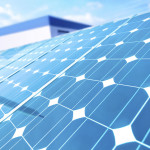Photovoltaics / Solar Electric Systems
Photo is Greek for Light and Voltaic is after Allesandro Volta pioneer in the study of electricity. Thus photovoltaic means *light to electricity*. The photovoltaics (PV) convert sunlight directly to direct current (DC) electricity by use of a semiconductor.
Solar cells are made from a chemical element called silicon. Silicon is one of the most common substances on Earth and can be found in most semiconductors/integrated circuits today.
A semiconductor p-n junction produces an electric field that is maintained purely by virtue of the material. In other words, no external voltage need be applied. For a solar cell, this means that when light hits the cell, electrons are bumped from atoms and drawn to one side of the junction by the internal electric field producing a current. When current flows you have electricity.
Silicon PV comes in many varieties. Shell PV panels are made with single-crystal silicon. These cells are cut from a single crystal of silicon. Single crystals give the highest efficiency of conversion of light to electricity at 15 to 17%. Solarex panels are made of polycrystalline silicon. Astropower PV panels are made of microcrystalline silicon. A very different type of cell is made of amorphous silicon, that is completely non-crystalline. Efficiencies of these cells are about 6%, much lower than crystalline. The beauty of amorphous silicon is the thin film material which can be made into an ultra thin backing. It can be made into flexible products such as Unisolar PV shingles and PV Laminates.
There is one other type of PV material which is common in the aerospace industry called gallium arsenide. These cells can be 30% efficient and are resistant to radiation damage. They are still very expensive and used only on spacecraft.
Because the solar cell is a solid state device, it can last for decades. The only part of a panel which can degrade is the material which encapsulates the cells. Some of these materials will brown if subjected to multiplied sunlight such as a magnifying glass or after many decades of regular exposure. Solar panels are not fragile. They are subjected to hail tests with 1 inch hail stones at a speed of 50mph.
All indications are that solar panels installed today, will still be working perfectly in 30 years. Most panels have a 25 year warranty from the manufacturer. Some PV manufacturers include Sharp, 1Soltech, Atlantis, Kyocera, Unisolar, Suntech and Schuco.

